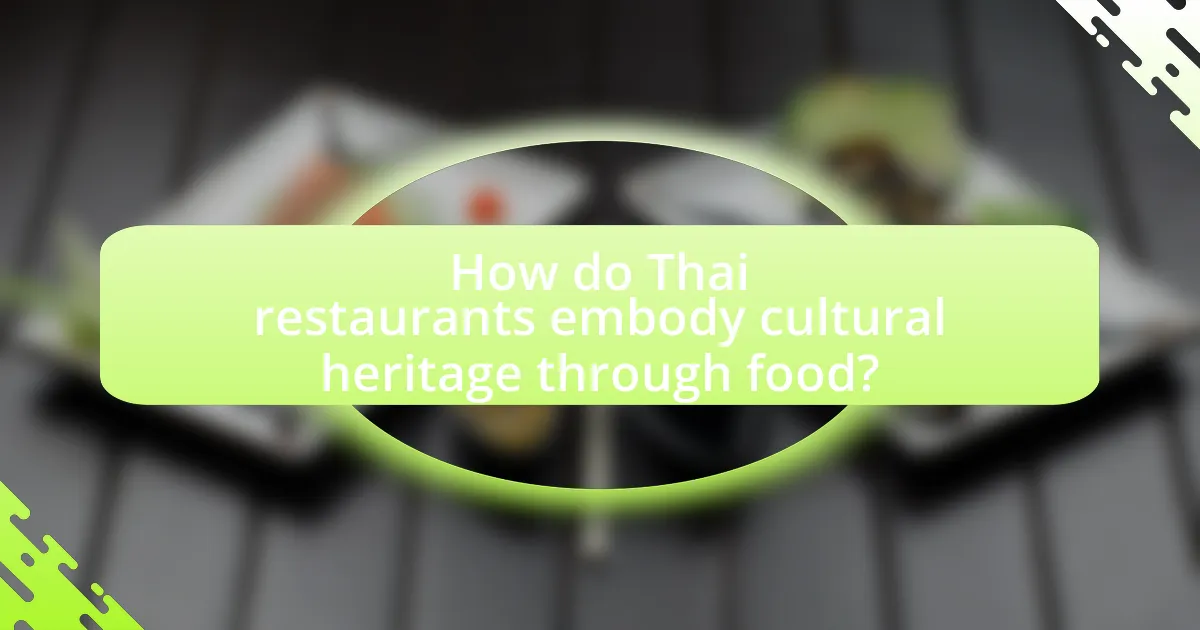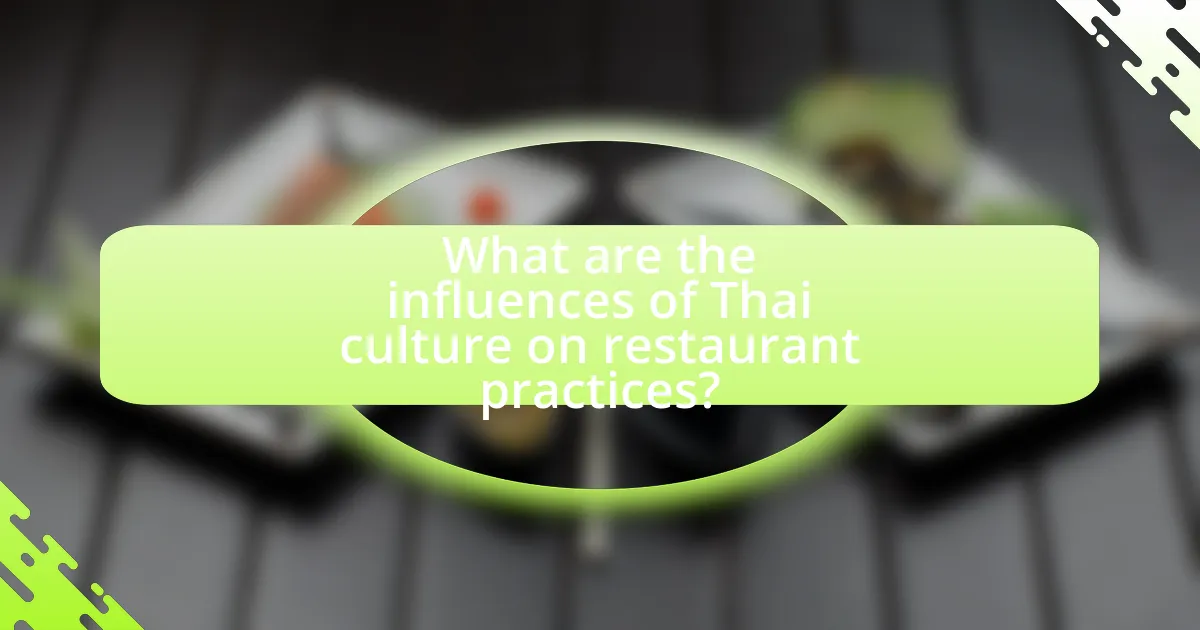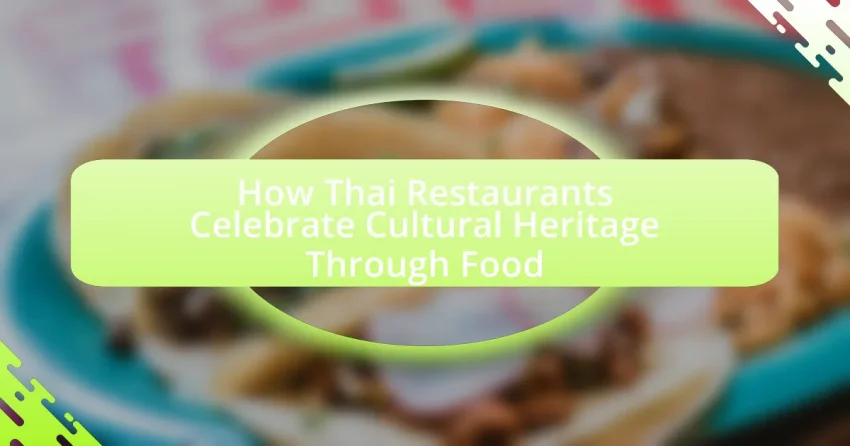Thai restaurants serve as vital representations of Thailand’s cultural heritage, showcasing traditional recipes, ingredients, and cooking techniques that reflect the country’s diverse regional cuisines. Key dishes such as Pad Thai, Tom Yum, and Green Curry illustrate the balance of flavors central to Thai philosophy, while the presentation of food emphasizes aesthetics and communal dining practices. The article explores how these restaurants incorporate local customs, celebrate cultural festivals through food, and utilize traditional cooking methods, all of which enhance the authenticity of the dining experience. Additionally, it highlights the significance of family involvement in food preparation and the role of festivals in shaping menu offerings, ultimately reinforcing the connection between food and Thai cultural identity.

How do Thai restaurants embody cultural heritage through food?
Thai restaurants embody cultural heritage through food by showcasing traditional recipes, ingredients, and cooking techniques that reflect Thailand’s diverse regional cuisines. These establishments often feature dishes like Pad Thai, Tom Yum, and Green Curry, which are rooted in centuries-old culinary practices and local customs. For instance, the use of fresh herbs, spices, and unique flavor profiles, such as the balance of sweet, sour, salty, and spicy, illustrates the Thai philosophy of harmony in food. Additionally, many Thai restaurants incorporate cultural elements in their decor and dining experience, further enhancing the representation of Thai heritage. This connection to cultural identity is evident in the way food is prepared and served, often emphasizing communal dining, which is a significant aspect of Thai culture.
What traditional Thai dishes are commonly featured in restaurants?
Traditional Thai dishes commonly featured in restaurants include Pad Thai, Tom Yum Goong, Green Curry, and Som Tum. Pad Thai is a stir-fried noodle dish that combines rice noodles, shrimp or chicken, peanuts, and bean sprouts, reflecting the balance of flavors in Thai cuisine. Tom Yum Goong is a spicy and sour soup made with shrimp, lemongrass, and kaffir lime leaves, showcasing the use of fresh herbs and spices. Green Curry, known as Gaeng Keow Wan, consists of green curry paste, coconut milk, and meat or vegetables, highlighting the richness of Thai flavors. Som Tum, a green papaya salad, emphasizes the use of fresh ingredients and the balance of sweet, sour, and spicy tastes. These dishes are staples in Thai restaurants, representing the country’s culinary heritage and cultural identity.
How do these dishes reflect regional variations in Thai cuisine?
Dishes in Thai cuisine reflect regional variations through distinct ingredients, cooking techniques, and flavor profiles unique to each area. For example, dishes from the northern region often feature herbs and spices like lemongrass and galangal, while southern Thai cuisine is known for its use of coconut milk and seafood, showcasing the coastal geography. Additionally, the northeastern region, or Isan, emphasizes sticky rice and bold flavors, often incorporating fermented ingredients. These regional characteristics are rooted in local agricultural practices and cultural influences, illustrating how geography and history shape culinary traditions in Thailand.
What ingredients are essential for authentic Thai cooking?
Essential ingredients for authentic Thai cooking include fish sauce, lime juice, lemongrass, galangal, and Thai basil. Fish sauce, a fermented product made from anchovies, provides the umami flavor that is fundamental in Thai dishes. Lime juice adds acidity and brightness, balancing the flavors. Lemongrass and galangal contribute aromatic and citrusy notes, essential for the characteristic Thai flavor profile. Thai basil, with its distinct anise-like flavor, is often used in stir-fries and curries, enhancing the dish’s complexity. These ingredients are integral to traditional recipes, reflecting Thailand’s culinary heritage and regional diversity.
Why is the presentation of food important in Thai culture?
The presentation of food is important in Thai culture because it reflects the values of harmony, respect, and artistry. In Thai cuisine, the visual appeal of a dish is considered as significant as its taste, with vibrant colors and intricate arrangements symbolizing the balance of flavors and ingredients. This emphasis on aesthetics is rooted in the cultural belief that food should be a feast for the eyes as well as the palate, enhancing the dining experience. Additionally, the meticulous presentation showcases the chef’s skill and dedication, reinforcing the cultural significance of hospitality and the communal aspect of sharing meals in Thai society.
How does food presentation enhance the dining experience?
Food presentation enhances the dining experience by engaging the senses and creating an emotional connection to the meal. Visually appealing dishes stimulate appetite and anticipation, which can lead to a more enjoyable dining experience. Research indicates that attractive food presentation can increase perceived taste and satisfaction; for instance, a study published in the journal “Appetite” found that participants rated food as more flavorful when it was presented beautifully compared to when it was served in a less appealing manner. This suggests that the aesthetics of food not only influence initial impressions but also enhance overall enjoyment, making the dining experience more memorable.
What cultural symbols are represented in the presentation of Thai dishes?
The presentation of Thai dishes represents several cultural symbols, including the use of vibrant colors, intricate garnishing, and traditional serving styles. These elements reflect Thailand’s rich cultural heritage, where colors symbolize different meanings; for example, red signifies good fortune and happiness. Intricate garnishing, such as vegetable carvings, showcases the artistry and craftsmanship inherent in Thai culture, often seen during festivals and celebrations. Traditional serving styles, such as communal sharing, emphasize the importance of family and community in Thai society, reinforcing social bonds. These symbols collectively highlight the significance of food as a medium for cultural expression in Thailand.
How do Thai restaurants incorporate local customs and traditions?
Thai restaurants incorporate local customs and traditions by integrating regional ingredients, traditional cooking methods, and cultural dining practices into their menus and dining experiences. For instance, many Thai restaurants use locally sourced produce and spices to create authentic dishes that reflect the flavors of specific Thai regions, such as the use of lemongrass and galangal in Central Thai cuisine. Additionally, these establishments often adopt traditional serving styles, such as sharing dishes among diners, which aligns with the Thai cultural emphasis on communal eating. Furthermore, many Thai restaurants celebrate local festivals and customs by offering special menus or themed events that highlight traditional dishes associated with specific holidays, such as Songkran or Loy Krathong, thereby reinforcing their connection to Thai cultural heritage.
What role does family play in the preparation and serving of Thai food?
Family plays a crucial role in the preparation and serving of Thai food, as it is often a communal activity that fosters cultural traditions and culinary skills. In many Thai households, family members collaborate in cooking, passing down recipes and techniques through generations, which preserves the authenticity of the cuisine. This practice not only strengthens familial bonds but also ensures that traditional flavors and methods are maintained, reflecting the cultural heritage of Thailand. For instance, family gatherings often revolve around meal preparation, where each member contributes, highlighting the importance of shared experiences in Thai culinary culture.
How do festivals influence the menu offerings in Thai restaurants?
Festivals significantly influence the menu offerings in Thai restaurants by prompting the inclusion of traditional dishes that reflect cultural heritage and seasonal ingredients. During festivals such as Songkran and Loy Krathong, Thai restaurants often feature special items like Khao Chae (rice in cool water) and various desserts that are traditionally prepared for these occasions. This practice not only honors cultural customs but also attracts customers seeking authentic festival experiences, thereby enhancing the restaurant’s connection to Thai traditions.

What are the influences of Thai culture on restaurant practices?
Thai culture significantly influences restaurant practices through its emphasis on communal dining, the use of fresh and local ingredients, and the integration of traditional cooking techniques. Communal dining reflects the Thai value of sharing and togetherness, often seen in the way dishes are served family-style, encouraging interaction among diners. The focus on fresh and local ingredients is rooted in Thailand’s agricultural practices, where seasonal produce is prioritized, enhancing the authenticity and flavor of the cuisine. Traditional cooking techniques, such as stir-frying and steaming, are commonly employed in Thai restaurants, preserving the cultural heritage and culinary identity of Thailand. These practices not only enhance the dining experience but also promote the cultural significance of food in Thai society.
How do Thai restaurants celebrate cultural festivals through food?
Thai restaurants celebrate cultural festivals through food by offering traditional dishes that reflect the significance of each festival. For example, during Songkran, the Thai New Year, restaurants may serve dishes like Khao Chae, which consists of rice soaked in jasmine-scented water, symbolizing purification and renewal. Additionally, during Loy Krathong, restaurants often feature desserts like Khanom Krok, which are coconut pancakes, representing the floating of krathongs to honor the water goddess. These culinary offerings not only highlight the cultural heritage of Thailand but also engage diners in the festive spirit, making the dining experience a celebration of tradition and community.
What specific dishes are prepared for major Thai festivals?
Specific dishes prepared for major Thai festivals include Khao Chae during Songkran, which consists of rice soaked in iced water served with various side dishes, and Khao Niew Mamuang, a mango sticky rice dessert commonly enjoyed during the Thai New Year. Additionally, during Loy Krathong, people often prepare dishes like Pad Thai and various types of curries to celebrate the festival. These dishes reflect the cultural significance and traditional practices associated with each festival, showcasing Thailand’s rich culinary heritage.
How do these celebrations impact customer engagement in restaurants?
Celebrations in Thai restaurants significantly enhance customer engagement by creating immersive cultural experiences. These events often feature traditional music, dance, and special menus that reflect Thai heritage, which attract both existing and new customers. For instance, during festivals like Songkran, restaurants may offer unique dishes and themed decorations, leading to increased foot traffic and social media buzz. Research indicates that experiential dining can boost customer loyalty and satisfaction, as patrons feel a deeper connection to the culture being celebrated. This connection often translates into repeat visits and positive word-of-mouth, further solidifying customer engagement.
Why is the use of traditional cooking methods significant?
The use of traditional cooking methods is significant because it preserves cultural heritage and enhances the authenticity of culinary experiences. Traditional techniques, such as slow cooking and the use of local ingredients, reflect the historical practices and values of a culture, particularly in Thai cuisine where methods like steaming and stir-frying are integral. These methods not only contribute to the unique flavors and textures of dishes but also foster a connection to the community’s identity and history, ensuring that culinary traditions are passed down through generations.
What are the traditional cooking techniques used in Thai cuisine?
Traditional cooking techniques used in Thai cuisine include stir-frying, steaming, grilling, and deep-frying. Stir-frying, often done in a wok, allows for quick cooking at high heat, preserving the flavors and textures of ingredients. Steaming is commonly used for dishes like dumplings and fish, ensuring moisture retention and enhancing natural flavors. Grilling, particularly over charcoal, imparts a smoky flavor to meats and vegetables, while deep-frying is utilized for creating crispy textures in dishes such as spring rolls and fried fish. These techniques reflect Thailand’s emphasis on balancing flavors and textures, showcasing the country’s culinary heritage.
How do these methods contribute to the authenticity of the food?
These methods enhance the authenticity of the food by preserving traditional cooking techniques and using locally sourced ingredients. Traditional cooking methods, such as stir-frying and steaming, reflect the cultural heritage of Thai cuisine, ensuring that the flavors and textures remain true to their origins. Additionally, the use of fresh, local ingredients supports the authenticity by maintaining the integrity of traditional recipes, as these ingredients are often integral to the unique taste profiles of Thai dishes. For instance, the incorporation of herbs like lemongrass and galangal, which are staples in Thai cooking, reinforces the cultural significance and authenticity of the food served in Thai restaurants.

How can diners appreciate Thai cultural heritage through food?
Diners can appreciate Thai cultural heritage through food by experiencing traditional dishes that reflect the country’s history, geography, and customs. For instance, dishes like Pad Thai and Tom Yum showcase the influence of Chinese and Malay cuisines, illustrating Thailand’s historical trade connections. Additionally, the use of fresh herbs and spices, such as lemongrass and galangal, highlights the importance of local agriculture and regional flavors in Thai culture. Furthermore, dining experiences that incorporate traditional cooking methods, such as grilling and steaming, allow diners to engage with the culinary practices passed down through generations, reinforcing the cultural significance of food in Thai society.
What should diners know about the cultural significance of Thai dishes?
Diners should know that Thai dishes are deeply rooted in the country’s cultural heritage, reflecting its history, geography, and social customs. The use of fresh ingredients and bold flavors in Thai cuisine symbolizes the importance of balance and harmony, which are central to Thai culture. For instance, the combination of sweet, sour, salty, and spicy elements in dishes like Pad Thai and Tom Yum illustrates the Thai philosophy of achieving equilibrium in life. Additionally, many Thai dishes are associated with specific festivals and rituals, such as the preparation of Khao Chae during the Songkran festival, highlighting the role of food in cultural celebrations and community bonding. This connection between food and cultural identity is essential for diners to appreciate the significance of each dish beyond its taste.
How can understanding the history of a dish enhance the dining experience?
Understanding the history of a dish enhances the dining experience by providing context and depth to the flavors and ingredients used. When diners learn about the origins of a dish, such as how Thai cuisine reflects the influences of neighboring cultures and historical trade routes, they gain a greater appreciation for its complexity. For example, the use of spices in Thai food can be traced back to ancient trade with India and China, which informs the unique balance of sweet, sour, salty, and spicy flavors. This historical insight allows diners to connect emotionally with the food, transforming a simple meal into a cultural journey that enriches their overall experience.
What are some common misconceptions about Thai food that diners should avoid?
Common misconceptions about Thai food include the belief that all Thai dishes are extremely spicy, that Thai food is primarily about curry, and that it lacks variety. While many Thai dishes do feature heat, there are numerous options that are mild and flavorful, catering to diverse palates. Additionally, Thai cuisine encompasses a wide range of dishes beyond curry, including stir-fries, salads, and soups, showcasing a rich variety of ingredients and cooking techniques. Furthermore, the notion that Thai food is solely about flavor overlooks the importance of presentation and balance, which are integral to the dining experience in Thai culture.
What tips can enhance the experience of dining at a Thai restaurant?
To enhance the experience of dining at a Thai restaurant, consider exploring the diverse menu offerings, including regional specialties like Som Tum (spicy papaya salad) and Massaman Curry, which reflect Thailand’s rich culinary heritage. Engaging with the staff to learn about the ingredients and preparation methods can deepen your appreciation for the cultural significance of the dishes. Additionally, pairing meals with traditional Thai beverages, such as Thai iced tea or Singha beer, can complement the flavors and elevate the dining experience.
How can diners choose dishes that reflect authentic Thai flavors?
Diners can choose dishes that reflect authentic Thai flavors by selecting items that feature traditional ingredients and cooking techniques. Authentic Thai cuisine emphasizes the balance of five fundamental flavors: sweet, sour, salty, bitter, and spicy, often achieved through the use of fresh herbs, spices, and sauces like fish sauce, tamarind, and chili paste. Dishes such as Pad Thai, Tom Yum soup, and Green Curry are rooted in regional Thai culinary practices and highlight the use of local produce and proteins. Additionally, diners should look for restaurants that source their ingredients locally and prepare dishes in accordance with traditional recipes, as this practice preserves the cultural heritage and authenticity of Thai food.
What etiquette should diners observe when enjoying Thai cuisine?
Diners enjoying Thai cuisine should observe the etiquette of sharing dishes and using utensils properly. In Thai dining culture, meals are typically served family-style, where multiple dishes are placed in the center for everyone to share, promoting a sense of community and togetherness. Additionally, it is customary to use a fork and spoon, with the fork used to push food onto the spoon, as opposed to using chopsticks, which are less common in Thai dining. This practice reflects the cultural emphasis on harmony and respect during meals.
